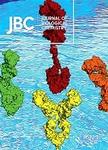版权所有:内蒙古大学图书馆 技术提供:维普资讯• 智图
内蒙古自治区呼和浩特市赛罕区大学西街235号 邮编: 010021

作者机构:Harvard Univ Brigham & Womens Hosp Dept Med Boston MA 02115 USA
出 版 物:《JOURNAL OF BIOLOGICAL CHEMISTRY》 (生物化学杂志)
年 卷 期:1999年第274卷第24期
页 面:17058-17062页
核心收录:
学科分类:0710[理学-生物学] 071010[理学-生物化学与分子生物学] 07[理学]
基 金:NHLBI NIH HHS [HL35610 HL46631 HL35252] Funding Source: Medline
主 题:1-肌氨酸-8-异亮氨酸血管紧张素Ⅱ/类似物和衍生物 1-肌氨酸-8-异亮氨酸血管紧张素Ⅱ/代谢 衔接蛋白质类 信号转导 氨基酸序列 血管紧张素Ⅱ/药理学 碱基序列 载体蛋白质类/遗传学 载体蛋白质类/代谢 克隆 分子 DNA 互补/遗传学 剂量效应关系 药物 酶激活 分子序列数据 蛋白质结合 受体 血管紧张素 1型 受体 血管紧张素 2型 受体 血管紧张素/代谢 重组蛋白质类/代谢 酿酒酵母菌/遗传学 组织分布 C型磷脂酶类/代谢 动物 小鼠
摘 要:The carboxyl-terminal cytoplasmic domain of the angiotensin II type 1 (AT(1)) receptor has recently been shown to interact with several classes of cytoplasmic proteins that regulate different aspects of AT(1) receptor physiology. Employing yeast two-hybrid screening of a mouse kidney cDNA library with the carboxyl-terminal cytoplasmic domain of the murine AT(1a) receptor as a bait, we have isolated a novel protein with a predicted molecular mass of 18 kDa, which we have named ATRAP (for AT(1) receptor-associated protein). ATRAP interacts specifically with the carboxyl-terminal domain of the AT(1a) receptor but not with those of ansotensin II type 2 (AT(2)), m(3) muscarinic acetylcholine, bradykinin B-2, endothelin B, and beta(2)-adrenergic receptors, The mRNA of ATRAP was abundantly expressed in kidney, heart, and testis but was poorly expressed in lung, liver, spleen, and brain. The ATRAP-AT(1a) receptor association was confirmed by affinity chromatography, by specific co-immunoprecipitation of the two proteins, and by fluorescence microscopy, showing co-localization of these proteins in intact cells. Overexpression of ATRAP in COS-7 cells caused a marked inhibition of AT(1a) receptor-mediated activation of phospholipase C without affecting m(3) receptor-mediated activation. In conclusion, we have isolated a novel protein that interacts specifically with the carboxyl-terminal cytoplasmic domain of the AT(1a) receptor and affects AT(1a) receptor signaling.